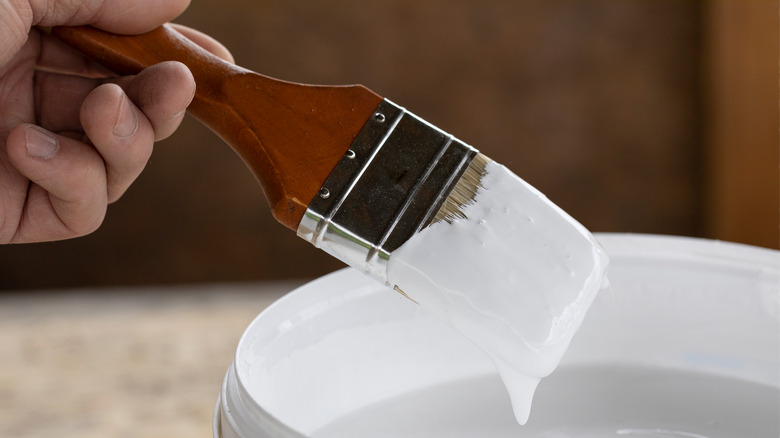Oil Paint Vs Latex: What's The Difference And Which Should You Choose?
There are so many ways to decorate your home and make improvements. Painting is one of the easiest and most affordable ways to transform a space. In fact, every year, Americans buy 1.57 billion gallons of paint for their homes (via Home Stratosphere). Choosing what kind of paint to use can, however, be pretty overwhelming. Not only do you have to pick the perfect paint color and shade that will work best, but then you need to choose the finish you want and figure out if you should buy a separate primer or use a two-in-one product.
On top of those decisions, there are so many different types of paint on the market. Joey Corona, senior merchant from Home Depot stated, "It's important to understand the differences between paint types in order to pick which one is best for your home and the specific project you're tackling" (via House Beautiful). Paint for homes is generally categorized into oil-based and water-based formulas (which are also known as latex paints). Each type has advantages and disadvantages as well as ideal applications. Whether you have an interior or exterior paint job in your future, this guide will help you learn the difference between oil and latex paint and choose which is best for your next project. Hopefully, once you have a better understanding of the two types, the next time you have to do some painting in your home you can have an easier time deciding what will be a better choice.
Types of oil paint
Before exploring the differences between oil and latex paint, it's important to understand the types of oil paint on the market. Oil paints are made using natural or synthetic oils. According to Joey Corona, "They consist of a pigment and a resin in a solvent thinner. When the thinner evaporates, the resin forms a hard coating. Painters should use an oil-based paint for any surface where they want the finish to last for a long time, and they are not planning to change the color often" (via House Beautiful).
Synthetic oils, like alkyd oil, make for highly durable paint that'll look fresh for years. Paint made with synthetic oil is inexpensive, but has a very strong smell as it dries. The most significant disadvantage of paint made with synthetic oils, however, is that this type of paint emits high levels of Volatile Organic Compounds (VOCs). VOCs are considered to be bad for your health, and you should avoid inhaling them. Therefore, when painting with a synthetic oil-based paint, you need to make sure to wear a protective mask and keep the space you are working in well ventilated (via Bob Vila).
Oil paints made with natural oil typically utilize linseed oil and are generally a bit pricier than paint made with synthetic oil. The advantage of oil paints made with natural oil, however, is that they don't emit high quantities of VOCs and are therefore safer to use inside the home (via Bob Vila).
The pros and cons of oil paint
Oil-based paint on a surface is more durable and resistant to scuffing, chipping, and peeling (via Home Stratosphere). If you're in your forever home and want to paint as infrequently as possible, oil paint makes a great choice. Many painters find it easier to use because it provides a smooth finish, according to HGTV. A single coat yields high coverage, so you may not even need a second coat depending on the job.
One major downside, however, is that oil-based paint takes quite some time to dry when used. Depending on various conditions — including room temperature and humidity — oil paint can take as long as 16 hours to dry (via Bob Vila). This means that you might have to wait days in between coats, making the job take much longer. Oil-based paint is also trickier to clean up if you get any on your floors or ceiling. According to HGTV, it requires a paint-thinner like turpentine, whereas water-based paint is much easier to remove. The last disadvantage is that oil-based paints tend to take on a yellow hue as time passes, so be mindful of that when choosing light colors.
The pros and cons of latex paint
According to Bob Vila, latex paints — also known as water-based paints — are typically the go-to pick for home interiors. They're a bit pricier than oil-based paints, and they're not as durable, meaning rooms painted with latex paint may have to be repainted at a higher frequency. Latex painted walls won't yellow, per HGTV, and the paint does have a couple additional advantages which make it the most popular choice to use indoors.
First off, when compared to oil-based paint, latex paint is a lot less poisonous, as the majority of its base is water (via Hunker). Cleaning up latex paint is a total breeze, because most of the time it washes off with plain water or a mixture of soap and water, according to HGTV. In addition, latex paint dries very quickly, meaning you can often paint an entire room in a single day with multiple coats. This is great when you are doing the project yourself, and also when you are paying a painter to do the job. Obviously, the longer the paint takes to dry in your home, the longer it will take a painter to finish.
How to choose between oil paint and latex paint
One primary consideration when choosing your paint is whether your walls are already covered with oil or water-based paint. The easiest way to verify this is to coat a rag with denatured alcohol, and rub it on the wall. If paint comes off on the rag, it's likely latex paint that the wall's currently coated in. If your walls have already been painted with latex paint, repaint using a similar product. The reason for this is oil-based paint may not adhere properly (via House Beautiful).
In terms of when to use oil-based paints, painting expert Josh Abramsonm stated, "Oil-based paints provide better surface penetration than other paints, as well as better adhesion. Oil-based paints are great at stain blocking, which makes them a good choice for stained surfaces, bleeding woods, and metals that can rust" (via Home Stratosphere). Many people opt for oil-based paint for both interior and exterior trims, because it can withstand plenty of everyday wear and tear — especially in busy households. For the same reason, oil-based paint is an excellent pick for painting cabinetry. Because it holds up well to moisture exposure, it's prudent to use oil-based paint in kitchens and bathrooms.
Latex paints are generally the best choice for all other indoor projects — especially when you want to get the job done quickly. Just be absolutely sure to have your home properly ventilated when you're painting by opening up windows and/or putting on a respirator (via eHow).




